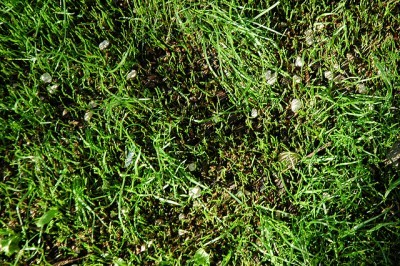






Overseeding is commonly recommended when otherwise healthy lawns exhibit brown patches or grass begins to die out in spots. Once you have determined that the cause is not insects, disease or mis-management, overseeding can help you recover the area with healthy blades of grass. There is a right time and method to overseeding for successful coverage. Learn when to overseed a lawn and how to overseed lawns for a lush green turf.
What is overseeding? It is simply seeding over an area that has or had existing grass that is performing poorly. There are two main reasons to overseed your lawn. First, if the lawn is patchy or thin. Secondly, if you are growing a warm-season grass that goes dormant and brown in winter, you can overseed with a cool-season turf seed so you have year around green grass.
Primarily the reasons are the result of aesthetic desires. The emerald green expanse of a perfect lawn is attractive to most homeowners. Overseeding can be costly and requires careful preparation of the area and subsequent maintenance. Timing and variety are important considerations when overseeding your lawn.
If your existing grass generally performs well, you can just use the variety that is already planted. In areas with webworm or other pest problems, you might want to choose a variety with an endophyte enhanced seed, which helps reduce pest problems. You need to pick a species that is suited to your climate and region.
Some good warm-season grasses are Bermuda grass and zoysia grass. For cooler climates, try a Kentucky blue or tall fescue. As you determine the best grass for overseeding, don’t forget to consider the lighting of the area. Fine fescues and shade tolerant Kentucky blue are great for dim areas.
The best time for overseeding your lawn is determined by the type of seed. For most species, spring is the best time to overseed the turf.
When you are overseeding for winter coverage, you may put down seed in early fall, but it requires quite a bit more management and irrigation to get the seed to take off.
Most grasses need a germination temperature of 59 to 77 degrees Fahrenheit. Do not seed when heavy freezes or snow are expected.
Preparation is an important part of the process. Rake and aerate the seedbed. Remove rocks and debris. Use the correct amount of seed in a seed spreader. Every species has a specific recommended seed rate.
Use a starter fertilizer to get the plants off to a healthy start. It is also a good idea to use a pre-emergent herbicide safe for young grass seedlings. Once you apply the seed, you may top dress lightly with soil; but in most cases, the aeration holes will catch the seed and they will grow there without top dressing.
Keep the area evenly moist until you see the seeds sprout. Then you can reduce irrigation gradually to match normally watering schedules. Wait to mow the grass until the area has filled in and the blades are at least an inch high.
crabgrass and grass planting timing.
What Material Is Best For Driveway Paving?
Synthetic Grass Prices for Installation and Maintenance
What is cost of artificial grass and how is it installed?
Find Best Company For Artificial Grass Lawns
What Is Ethylene Gas: Information On Ethylene Gas And Fruit Ripening
Copyright © www.100flowers.win Botanic Garden All Rights Reserved